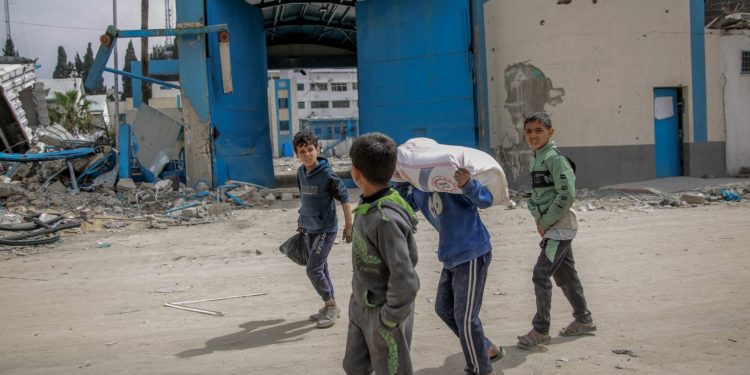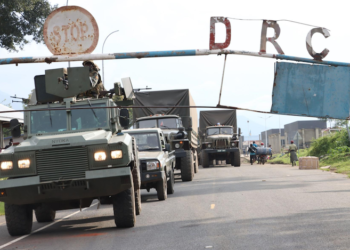By AL JAZEERA
Israel is using bureaucracy to “deliberately” hinder aid supplies headed into Gaza, Oxfam has claimed.
The NGO’s assertion was made in a report titled: Inflicting Unprecedented Suffering and Destruction, which was released on Monday. It came amid a rise in international protest against the shortages of food, water and medicine in the besieged and battered Palestinian enclave, with one United Nations agency warning that famine will arrive by May at the latest.
Oxfam detailed the rejection of a warehouse full of international aid including oxygen, incubators, and water and sanitation gear. The NGO said this is “just one example of an overall humanitarian response that Israel has made so dangerous and dysfunctional as to be impossible for aid agencies to work at the speed and scale necessary to save lives, despite best efforts”.
It went on to state that Israel is “breaking one of the key provisions demanded by the International Court of Justice (ICJ) – to boost humanitarian aid in light of the risk of genocide in Gaza”.
“People living in Gaza will suffer mass death from disease and starvation far beyond the current 31,000 Palestinian war casualties unless Israel takes immediate steps to end its violations,” it adds.
🚨BREAKING: New Oxfam report shows Israel continues to block aid in #Gaza despite ICJ #genocide court ruling.
Rejected aid, including Oxfam water and sanitation gear, is now stockpiling in a warehouse at Al Arish.
Here is our release👉https://t.co/geZgMg2EJ2#CeasefireNow pic.twitter.com/XvP4WAWfMs
— Oxfam International (@Oxfam) March 18, 2024
“The ICJ order should have shocked Israeli leaders to change course, but since then conditions in Gaza have actually worsened,” said Oxfam Middle East and North Africa director Sally Abi Khalil.
“Israeli authorities are not only failing to facilitate the international aid effort but are actively hindering it. We believe that Israel is failing to take all measures within its power to prevent genocide.”
Israel controls most of Gaza’s seven land crossings but only Rafah and Karem Abu Salem/Kerem Shalom crossings are open to aid, Oxfam said. Egypt partially controls the Rafah border.
A total of 15,413 trucks have been allowed into Gaza since October 7, according to the NGO, five times less than the minimum required.
Oxfam said its aid cargo is stuck at the El Arish warehouse in Egypt just 40 kilometres away from the Gaza border, and added trucks wait for 20 days on average to be able to pass through.
Scores of aid workers have been hit in Israeli attacks and some 400 aid seekers have been killed. The United States has resorted to aid airdrops that in one case proved fatal.
The US is also working on plans to construct a seaport. A vessel towing 200 tonnes of aid to test a European Union-backed effort to open a sea corridor arrived in Gaza last week.
Josep Borell, the EU’s foreign affairs chief, reiterated on Monday previous calls for Israel to lift the blockade, and again accused Tel Aviv of using starvation as a “weapon of war”.
“In Gaza, we are no longer on the brink of famine, we are in a state of famine, affecting thousands of people,” Borrell said, speaking at a conference on humanitarian aid for Gaza in Brussels. “This is unacceptable. Famine is being used as a weapon of war.”
Responding to Borell, Israeli foreign minister Israel Katz said Borell should stop “attacking” Israel, and blamed Hamas for disrupting aid.
“Israel allows extensive humanitarian aid into Gaza by land, air, and sea for anyone willing to help,” he said.
Famine by May
However, a United Nations-backed body warned in a separate report released on Monday that more than 200,000 people in northern Gaza – 70 percent of the population in the area – face famine between now and May.
Household malnutrition levels have likely reached or surpassed famine thresholds, with the results being looming “steep” rises in child deaths, the Integrated Food Security Phase Classification (IPC) report said.
The IPC is a scaling tool used globally to assess the risks of food shortages and provide early warnings to governments. It was developed by the UN and private partners and determines when the UN can formally declare a famine.
Virtually all households across Gaza are starving, the report found.
In the north, where one in three children under two years is already acutely malnourished, people in nearly two-thirds of households went days without food at least 10 times in the last 30 days, the report said.
Half of Gaza’s population – 1.11 million people – are now in IPC’s phase 5 or catastrophe stage, the highest indicator of a famine.
People in central and southern Gaza are already at phase 4 emergency levels – just one step from famine – according to the IPC.
“Waiting for a confirmation that famine is occurring or has actually occurred to take radical measures is indefensible,” the researchers said.







Discussion about this post